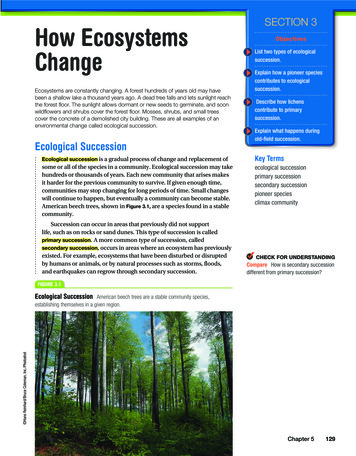
Transcription
How EcosystemsChangeEcosystems are constantly changing. A forest hundreds of years old may havebeen a shallow lake a thousand years ago. A dead tree falls and lets sunlight reachthe forest floor. The sunlight allows dormant or new seeds to germinate, and soonwild flowers and shrubs cover the forest floor. Mosses, shrubs, and small treescover the concrete of a demolished city building. These are all examples of anenvironmental change called ecological succession.Ecological SuccessionSection 3ObjectivesList two types of ecologicalsuccession.Explain how a pioneer speciescontributes to ecologicalsuccession.Describe how lichenscontribute to primarysuccession.Explain what happens duringold-field succession.Ecological succession is a gradual process of change and replacement ofKey Termssome or all of the species in a community. Ecological succession may takehundreds or thousands of years. Each new community that arises makesit harder for the previous community to survive. If given enough time,communities may stop changing for long periods of time. Small changeswill continue to happen, but eventually a community can become stable.American beech trees, shown in Figure 3.1, are a species found in a stablecommunity.ecological successionprimary successionsecondary successionpioneer speciesclimax communitySuccession can occur in areas that previously did not supportlife, such as on rocks or sand dunes. This type of succession is calledprimary succession. A more common type of succession, calledsecondary succession, occurs in areas where an ecosystem has previouslyexisted. For example, ecosystems that have been disturbed or disruptedby humans or animals, or by natural processes such as storms, floods,and earthquakes can regrow through secondary succession.Check for UnderstandingCompare How is secondary successiondifferent from primary succession?Figure 3.1 Hans Reinhard/Bruce Coleman, Inc./PhotoshotEcological Succession American beech trees are a stable community species,establishing themselves in a given region.Chapter 5129
Primary SuccessionFigure 3.2Pioneer Species Over a long period of time,lichens can break down rock into soil.Primary succession can occur on new islands created by volcaniceruptions, in areas exposed when a glacier retreats, or on anyother surface that has not previously supported life. Primarysuccession is much slower than secondary succession becauseprimary succession begins where there is no soil. It can takeseveral hundred to several thousand years to produce fertile soilnaturally. Imagine that a glacier melts and exposes an area of barerock. The first species to colonize the bare rock will most likelybe bacteria and lichens, which can live without soil. A speciesthat colonizes an uninhabited area and begins the process ofecological succession is called a pioneer species. Lichens, shownin Figure 3.2, are important pioneer species in primary succession.They are the colorful, flaky patches that you see on trees androcks. A lichen is a producer that is actually composed of twodifferent species, a fungus and green algae or cyanobacteria. Thealgae or the cyanobacteria photosynthesize, while the fungusabsorbs nutrients from rocks and holds water. Together, theybegin to break down the rock.CASESTUDYCommunitiesMaintained by Fire130Unit 2:EcologyFireweed is one type of plant that colonizesland after the land has been burned by fire.Longleaf pines have a strange growth pattern. Whenthey are young, they have long needles that reach downto the ground. The trees remain only about a half of ameter high for many years, while they store nutrients. If afire occurs, it sweeps through the tops of the tall trees thatsurvived the last fire. The young longleaf pines near theground may escape the fire. Then, the young pines usetheir stored food to grow very rapidly. A young pine cangrow as much as 2 m each year. Soon the young pines aretall enough so that a fire near the ground would not harmthem.If regular fires are prevented in a fire-adaptedcommunity, deciduous trees may invade the area. These(b) Radius Images/Alamy Images; (t) Imagebroker/Alamy ImagesFires set by lightning or human activities occasionallysweep through large areas. Burned areas undergosecondary succession. In the forests of the Rocky Moun tains, for example, burned areas are rapidly colonized byfireweed, which clothes the slopes with purple flowers.In some places, fire determines the nature of the climaxcommunity. In the United States, eco logical communitiesthat are maintained by fire include the chaparral ofCalifornia, the temperate grassland of the Midwest, andmany southern and western pine forests.Plants native to these communities are adapted to livingwith fire. A wildfire that is not unusually hot may not harmfire-adapted pine trees, but it can kill deciduous trees—those trees that lose their leaves in winter. Seeds of somespecies will not germinate until exposed to temperaturesof several hundred degrees. When a fire sweeps through aforest, the fire kills plants on the ground and stimulates theseeds to germinate.
As the growth of the lichen breaks down the rock, watermay freeze and thaw in cracks, which further breaks up therock. Soil slowly accumulates as dust particles in the air aretrapped in cracks in the rock.Figure 3.3Primary Succession in Urban Areas Plants(t) Norman Owen Tomalin/Bruce Coleman, Inc./Photoshot; (br) B.G. Wilson Fire/Alamy Images; (bl) Ken M. Johns/Photo Researchers, Inc.Dead remains of lichens and bacteria add to the soil in thecracks. Mosses may increase in number and break up the rockeven more. When the mosses die, they decay and add nutrients to the growing pile of soil. Thus, fertile soil forms fromthe broken rock, decayed organisms, water, and air. Primarysuccession can also be seen in any city street, as shown inFigure 3.3. Mosses, lichens, and weeds can establish themselves in cracks in a sidewalk or building. As well, fungi andmosses can invade a roof that needs repair. Even a big city,such as New York City, would eventually turn into a cementfilled woodland if it were not constantly maintained.that grow through cracks in city sidewalks can also bedescribed as pioneers of primary succession.These young lodgepole pine treeshave started growing after adevastating forest fire.trees form a thick barrier near the ground. In addition,their dead leaves and branches pile up on the ground andform extra fuel for fires. When a fire does occur, it is hotterand more severe than usual. The fire destroys not only thedeciduous trees but also the pines. It may end up as adevastating wildfire.Although it may seem odd, frequent burning is essentialto preserve many plant communities and the animals thatdepend on them. This is the reason the U.S. National ParkService adopted the policy of letting fires in national parksburn if they do not endanger human life or property.This policy caused a public outcry when fires burnedYellowstone National Park in 1988, because people did notunderstand the ecology of fire-adapted communities. Thefires later became an opportunity for visitors to learn aboutthe changes in an ecosystem after a fire.This firefighter is helping to maintain aCriticalThinkingcontrolledfire in South Dakota.Critical Thinking1. Understanding Processes Explain howa longleaf pine tree might be more likely tosurvive a forest fire than a deciduous tree,such as a maple or oak tree.2. Understanding Concepts Why mustcontrolled fires be set in some ecosystems?What are the advantages? What are thedisadvantages?Chapter 5:How Ecosystems Work131
Figure 3.4Secondary Succession This illustration showswhat an abandoned farm area might look like duringold-field succession, a type of secondary succession.critical thinkingInfer Why do you think smaller plants disappearafter pine trees begin to grow?Secondary SuccessionWhen a community is partially or completely destroyed by a natural or ahuman-caused disaster, another community eventually takes its place.For example, when fire destroys a forest, new communities begin to growin place of the old ones. Pioneer species colonize the area first and, overtime, more stable species become established. A climax community is afinal and stable community. Even though a climax community continuesto change in small ways, this type of community may remain the samethrough time if it is not disturbed.Old-field SuccessionFieldStudyGo to Appendix B to find the field studyInvestigating Succession.132Unit 2:EcologyWhen farmland is abandoned, a type of secondary succession calledold-field succession occurs. When a field is no longer cultivated, pioneerspecies such as grasses and weeds quickly grow and cover the abandonedland. The grasses and weeds produce many seeds to cover large areas.Over time, taller plants grow in the area and shade the ground, keepinglight from the shorter plants. The long roots of the taller plants also absorb most of the water in the soil. The pioneer plants soon die from lackof sun light and water. As succession continues, growing trees deprive thetaller plants of light and water. Finally, slower-growing trees, such as oaks,hickories, beeches, and maples, take over the area and block sunlight tothe smaller trees. As shown in Figure 3.4, the area can eventually establisha climax community dominated by a mature oak forest. The field in Figure3.5 was once used as farm land, but has since been abandoned.
Figure 3.5Old-Field Succession This field was once plowed, but has since been abandoned for one or more growingseasons. It is slowly becoming forested land. Stephen Collins/Photo Researchers, Inc.Fire and Secondary SuccessionFires caused by lightning are a natural cause of secondary succession insome communities, as discussed in the Case Study. Some species of trees,such as the Jack pine, can release their seeds only after they have beenexposed to the intense heat of a fire. Minor forest fires remove accumulations of brush and deadwood that would otherwise contribute to majorfires that burn out of control. Fire is important in helping forests returnnutrients to the soil. Secondary succession uses these nutrients to grow.After a fire, heavy growth of small plants near the ground often occursand new trees flourish. Some animal species also depend on occasionalfires because they feed on the vegetation that sprouts after a fire hascleared the land. Therefore, foresters sometimes allow natural fires toburn unless the fires are a threat to human life or property.HMDScience.comProtecting NaturalResourcesCheck for UnderstandingIdentify List two ways that fire can bebeneficial to a forest community.Section 3 Formative AssessmentReviewing Main Ideas1. Compare primary and secondary succession.2. Describe what role a pioneer species playsduring the process of ecological succession.3. Explain why putting out forest fires may bedamaging in the long run.4. Describe the role lichens play in primary succession. Write a short paragraph to explainyour answer.Critical Thinking5. Analyzing Processes Over a period of 1,000years, a lake becomes a maple forest. Is thisprocess primary or secondary succession?Explain your answer.6. Analyzing Relationships How are lichenssimilar to the pioneer species that colonizeabandoned farm areas? How are they different?Chapter 5:How Ecosystems Work133
HMDScience.com Protecting Natural Resources Chapter 5: How Ecosystems Work 133 DO NOT EDIT--Changes must be made through "File info" CorrectionKey B. Title: EV_CNLESE904016_C05S3.indd Subject: CorrectionKey B










